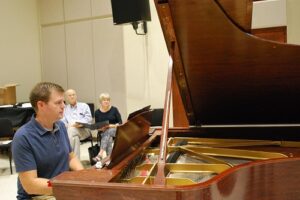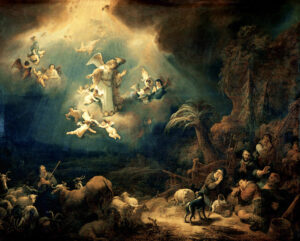Table of Contents
Introduction to the work and its composer Dan Forrest

Dan Forrest published his first choral piece, an arrangement of the hymn “Sun of My Soul,” in 2001. He was 23 years old and working on a degree in piano performance at the time. Beckenhorst Press, a major sacred music publisher, accepted the work after several others had rejected it, little knowing that Forrest would end up as an assistant editor for the organization and as the primary accompanist for their demo recordings. While Forrest had done some arranging and composing in his high school and college years, he concentrated on the piano until, as he says, “Eventually I just got kind of tired of the piano, where you press a note and it dies.” (See the J. W. Pepper video below for the full interview.) He became more and more interested in vocal music, eventually earning his doctorate in composition. He’s also studied with a number of prominent American choral composers, among them Alice Parker, whom Forrest considers to be a foremost influence. He’s now much in demand as a composer, arranger, conductor, speaker and clinician and has left full-time teaching so that he can devote more time to his own writing.
My own choir, the Cherry Creek Chorale in the Denver area, has performed many Forrest compositions/arrangements, starting in December 2014 with “Christmas Joy.” his arrangement of three traditional carols. In the years since that initial performance we’ve sung a number of Forrest pieces, including his major multi-part work Three Nocturnes, settings of three American poems about night, stars, and the heavens in general, which formed the centerpiece of a concert titled “Starry, Starry Night.” The choir enjoys performing Forrest’s music, and I very much hope that LUX will be on a program soon.
The original 2017 SATB setting of LUX was commissioned by Gordon and Sarah Herring, long-time supporters of the Greenville Chorale in South Carolina, the organization that premiered the work. I’ve not been able to find any specific information on how the Herrings decided to pursue this commission, but Forrest’s growing prominence in the field of choral music and the fact that he lives in Greenville may have played a part in the decision. There can be many paths to a musical commission; if you’re interested in further information on the topic I’d encourage you to read my post “How does this whole commissioning process work?.”
I’m on Forrest’s mailing list and received word in early 2022 that he was forming a choir consortium to participate in a new voicing of LUX for SSAA parts. This type of group sponsorship seems to have become more popular over the past few years. Composers who have a network of contacts and have achieved a certain level of popularity and success can let it be known that they have a work available for participants. Everyone comes out ahead in this situation: the composer receives financial support and a guaranteed number of performances, while the choir gets premier rights, its name on the piece, and any number of extra perks. My own choir has taken part so far in two consortia, personally interacting with the composer in both cases.
As for the work itself, its texts are a mix, with Scripture, ancient hymns, and modern poetry. Here’s what Forrest says on his website about the arc of ideas he assembled:
As a whole, the five movements trace a symmetrical journey through time–from ancient prophecy, to today (“even after all this time”), and then back again; or from another perspective, from a day’s dawn, through the sun’s high point in the sky, and then to the setting of the sun on the horizon at the end of day.
Note that Forrest makes it clear that he chose the texts himself, something that wouldn’t have happened had he been writing in the sacred liturgical tradition any time before, say, 1870. Bach, Mozart or Verdi, for instance, sitting down to write a Roman Catholic Mass, would have had the texts already to hand. (Bach’s B Minor Mass is indeed Roman Catholic even though he himself was a Protestant. There’s a fascinating story behind that composition which I can’t get into now.) On the one hand those composers were relieved of the responsibility of finding texts; on the other hand they were limited by them. One very positive aspect of writing this type of music set to predetermined texts would have been that the composer had a built-in performance venue, especially if he were writing as an employee of a specific church. He might even get to direct his own composition using the church choir.
The situation is very different today, of course, with most composers choosing their own texts, having them written specifically for them, or writing the texts themselves. It would be interesting to find out what process Forrest went through as he chose the lyrics for LUX. All of the Christian texts he uses in the work have at least a tenuous connection to Christmas. But the central text in part III is a poem by the modern writer Daniel Ladinsky, a Muslim who writes in the style of ancient Persia, so the texts as a whole defy pigeonholing.
Although I haven’t been able to interview Forrest directly about his textual analyses, I was able to find a couple of sources that do include ideas on that subject. First, here’s the above-mentioned interview conducted by the sheet music company J. W. Pepper in which he talks about how he decided to become a composer/arranger instead of a piano performer, with a fairly extensive section about how he decides on texts. This interview was recorded in 2016, so well before his composition of LUX:
And here’s what the conductor of the Greenville Chorale had to say about how Forrest works through textual choices:
Conductor Bingham Vick Jr. says “Lux,” meaning “light,” should be completed in July. Preliminary viewings of the texts Forrest is working with indicate the composition, which is for chorale, vocal soloists, and orchestra, will have broader appeal and not be limited to a specific time in the religious calendar, Vick says. “He takes a lot of time to consider and digest the text before he gets into the music,” Vick says of Forrest’s process. (“New Composition by Dan Forrest highlight of Greenville Chorale ’17-’18 season“)
I ran across this picture on the Greenville Chorale’s Facebook page, which I’m using to close out this introductory section:

The caption, dated October 2017, reads: “Sarah and Gordon Herring hearing Lux for the first time, while Dan Forrest edits at the piano. — with Gordon Herring and Sarah Herring at Harper Hall, Daniel Music Building, Furman University.” It’s a fascinating little glimpse into the interplay between the commissioners and the composer. I wonder what was going through everyone’s heads during this session; the Herrings look pleased, as well they should. LUX is a truly remarkable piece.
So now let’s turn to the texts. Let me emphasize that my commentaries focus almost exclusively on the words, their meaning and background, as I’m not in any way qualified to do musical analysis. My hope in writing this material is that a clearer and deeper understanding of the texts will enhance the understanding that you bring to the performance, whether as a singer, instrumentalist, or member of the audience.
Part I: “Illuminare”

| Per viscera misericordiae Dei nostri in quibus visitavit nos oriens ex alto illuminare his qui in tenebris et in umbra mortis sedent ad dirigendos pedes nostros in viam pacis. Lux ex alto, veni nos illuminare. |
By the tender mercy Of our God who has delivered Our dayspring from on high, Illuminate us who are in darkness And in the shadow of death sit And direct our steps in the way of peace. Light from on high, come illuminate us. |
| adapted from Luke 1:78-79 | |
| Lux de luce apparuisti Christe, cui Magi munera offerunt, Alleluia, alleluia, alleluia. |
Light from light you appeared, Christ, Whom the Magi munificent gifts offered. Alleluia, alleluia, alleluia. |
| Antiphon for Epiphany, 14th c. | Trans. Debi Simons |
The first movement of the work starts with a passage from the Gospel of Luke, beginning with the phrase “Per viscera misericordiae“– “By the tender mercy.” The literal meaning of “viscera” is “internal organs; intestines,” but we moderns tend to sanitize the wording of ancient texts and so rarely if ever use that translation today. We do use “visceral” in a metaphoric sense, though. If you have ever said, “I had a visceral reaction to the news,” what you meant was, “I felt it in my gut.” Think about how many expressions we use that are rooted in our physical reactions to outward events: “My stomach is tied up in knots,” or “I’m just sick about it” or “I don’t feel good about doing that.” The fact of the matter is that our physical selves are never totally divorced from our mental or physical ones.
So it would be a more accurate translation to echo the old King James version’s terms: “bowels of mercy.” That usage sounds totally strange to our modern ears but is very common in biblical language. A striking usage.of this intestinal imagery comes in the first book of the Bible, Genesis, in the story of Joseph and his brothers. Joseph has been sold into slavery because of a plot by those very same jealous brothers, has risen to the rank of vizier, second in command only to Pharaoh, and has pressed Egypt to stockpile grain for a coming famine. Now his brothers have come to the court, being sent by their father to get food. Joseph knows his brothers, but they don’t know him in his fancy robes and wig. When Joseph sees his younger brother Benjamin with them he’s overcome with emotion:
And Joseph made haste; for his bowels did yearn upon his brother: and he sought where to weep; and he entered into his chamber, and wept there. (43:30)
Can’t you just see Joseph rushing out from his brothers’ presence, holding his hand over his mouth to keep himself from sobbing aloud until he can get somewhere private? And that same intensity of emotion is applied in this text to God, who indeed “yearns” after us and is tender towards us.
We moderns may have moved away from associating our bowels with our emotions, but we still use the word “heart” to mean our emotions even though we know perfectly well that the actual physical heart is a blood-circulation pump. Perhaps there will come a day when to talk of a “broken heart” seems as strange to us as to talk of our “bowels of mercy.”* As for “misericordiae,” translated as “mercy,” you may have thought that the word must have some connection to the word “misery,” and indeed it does. You pray for mercy when you are in misery, as it were. God’s mercies are very much needed in a miserable situation.
How has that mercy been bestowed? By the coming of Christ, the dawn or “dayspring,” that latter being a lovely and archaic word that’s used only twice in the Bible and means “dawn.” Not to belabor the point, but the word makes sense. The light of the new day “springs” from the horizon.
A little etymology is helpful here in clarifying the words “oriens” and “alto.” You can see “the Orient” or “Oriental” in “oriens,” which means, simply, “east.” What about “alto”? To me that word refers to a lower woman’s voice; why is it being translated here as “on high”? There’s quite a bit of explanation to be found about this word, but here the relevant idea is that, while “alto” may refer to a low woman’s voice, it also refers to the highest male voice, today usually called a “countertenor.” Also, the Latin root is “altus,” clearly referring to “altitude.”
On to the next three lines. There are two active verbs: “illuminate” and “direct.” These verbs come as requests to God. There’s one inactive verb: “sit,” which describes those who are in darkness. God is being asked to do something for those who cannot or will not do anything for themselves as they remain where they are. And note the phrase “shadow of death.” It’s an echo of Psalm 23: “Yea, though I walk through the valley of the shadow of death, I will fear no evil: for thou art with me.” (KJV)
Forrest himself has apparently added the final line in this section: “Lux ex alto, veni nos illuminare,” as it does not appear in the original biblical text nor in any liturgical forms. I assume that he wanted to get in a specific request for God to send light before leaving these lines. And then he married the text from the Gospel of Luke with an ancient hymn, an “antiphon for epiphany.” The hymn is called an “antiphon” because originally there would have been multiple choirs singing for a Roman Catholic mass, and they’d sometimes trade verses and refrains back and forth between or among them, thus producing an “antiphonal” effect.
The first line of this antiphon echoes ideas from the Nicene Creed, one of the oldest surviving statements of Christian doctrine, about the identity of Christ:
God from God, Light from Light, true God from true God.
But this specific antiphon is tied to the Feast of Epiphany, usually celebrated on January 6, the twelfth day after Christmas, December 25. (You don’t count Christmas Day as one of the days, but you do count Jan. 6. Inclusive vs. exclusive counting can be very confusing.) This date is traditionally seen as when the Magi, the Wise Men, or the Three Kings, arrived in Bethlehem to worship the Christ child. There is almost no limit to the flood of information available about the data in the preceding sentence. If you’d like to read more about this subject you can follow this link: “Who Were the Magi?” Here I’ll just say that the arrival of these mysterious men and their offering of gifts rich in symbolism—gold, frankincense, and myrrh—constitute the “epiphany,” or “revelation,” of the Christ child’s identity. (The word comes from the Greek ἐπιφάνεια, epipháneia, meaning manifestation or appearance.) Nowadays, as a further example of how we moderns have lost touch with the profound meaning of ancient words, we use it almost solely to mean “a sudden idea or flash of insight,” as in “I just had an epiphany about how we could design the curtains at that window.”
The movement ends with a three-fold repetition of the word “alleluia,” which can also be spelled “hallelujah.” Wikipedia has this to say about the derivation and meaning of that word:
Hallelujah is a transliteration of the Hebrew phrase הַלְלוּ יָהּ (halelū yāh), which means “praise ye Jah!” (from הַלְלוּ, “praise ye!” and יָהּ, “Jah”.) The word hallel in Hebrew means a joyous praise in song. The second part, Yah, is a shortened form of YHWH (Yahweh or Jehovah in modern English).
Here’s a video of this individual section:
*I can’t resist also mentioning the word “reins,” used a few times in the KJV, which refers to our kidneys. Have you ever heard the expression “a man of his kidney”? This term, interestingly, has been used much more recently than the “bowel” reference. I will quote here from the 1935 novel Gaudy Night by Dorothy Sayers, in which the heroine Harriet Vane ponders how to get in touch with Lord Peter Wimsey about mysterious happenings at Oxford:
She would readily have contracted obligations to the devil himself if she had been sure that the prince of darkness was a gentleman of Peter’s kidney.
Part II: “Lux in Tenebris”

| Lux fulgebit hodie super nos, | Light will shine radiantly today on us, |
| quia natus est nobis Dominus. | for born unto us is the Lord. |
| (Introit for Christmas Dawn, 10th c.) | |
| Lux in tenebris lucet | The light in darkness has shown, |
| et tenebrae eam non superaverunt. | and the darkness has not overcome or understood it. |
| John 1:5 | Trans. Debi Simons |
Such a splendid pairing of texts for this section! A “Christmas Dawn” mass is one of three traditional services held in Roman Catholic churches to celebrate the specific events of Christmas Day. (The “introit” or “entrance” is the introductory section of the service when the officiants typically form a procession into the sanctuary.) Most of us, whatever our individual religious affiliation, know that there’s a mass at midnight on Christmas Eve, but there’s also one at dawn from which Forrest took this text and then one after the day has fully come. The three services are known as the angels’ mass, celebrating the announcement of the actual birth of Christ, traditionally said to have taken place at midnight, then the shepherds’ mass, portraying their arrival to the manger at dawn, and then the Three Kings’ mass, after the full light of day has come. (If you’d like some further info about the shepherds and the manger, you might like to read this post.)
The biblical narrative supports the idea of the shepherds’ knowledge that “born unto us is the Lord.” They had just been through quite a dramatic experience, sitting out in the night fields when suddenly “the angel of the Lord came upon them, and the glory of the Lord shone round about them: and they were sore afraid.” Understandably so, I would think. The angel then told them “Fear not: for, behold, I bring you good tidings of great joy, which shall be to all people. For unto you is born this day in the city of David a Saviour, which is Christ the Lord.” And so the shepherds said, as soon as the angel and accompanying heavenly host departed, “Let us now go even unto Bethlehem, and see this thing which is come to pass, which the Lord hath made known unto us.” No time to be wasted. “And they came with haste, and found Mary, and Joseph, and the babe lying in a manger.”* (Luke 2 KJV)
Note a couple of Latin words before we go on to the next section. First, “fulgebit.” You may have noticed the added word “radiantly” in the translation; it’s there because of the English word “effulgent,” which is derived from the Latin. If you say “his face was effulgent with joy,” you’re saying something much more descriptive than just the word “shone.” And “hodie”–how many times have you sung that word if you’ve ever performed traditional Christmas music in Latin? It means simply “this day” and doesn’t have anything to do with the clothing item known as a hoodie. (Although hooded monks have probably sung this word many times over the centuries: “Does ‘personant hodie‘ have anything to do with persons wearing hoodies?“)
The paired scriptural passage is from the Gospel of John. The first five verses at the beginning of John can be seen as the Christian message in miniature: Christ is presented as co-equal with God the Father (“and the Word was with God, and the Word was God”) and as being the light of that message: (“In him was life; and the life was the light of men.”) Now we get to the verse quoted in this section of LUX, and I’ve somewhat expanded on this translation also. Almost all more modern translations have something along the lines of “and the darkness could not put out that light.” But no—the most literal word-for-word translation, Young’s Literal Translation, says, “and the darkness did not perceive it.” Another alternate translation says, “and the darkness has not understood it.” So it’s not just that the light can’t be put out; it’s that the darkness of sin and death cannot even understand the light and its source. Putting both of these ideas together adds to the richness of the ideas.
Here’s a good performance of the individual movement by the same group as in Part I:
*What example concerning correct comma usage can be garnered from Luke 2:16?
The King James Version reads: “And they came with haste, and found Mary, and Joseph, and the babe lying in a manger.” But if you put a comma after “babe,” then all three of them end up in that very crowded manger.
Part III: “The Sun Never Says”

Even
After
All this time,
The sun never says to the earth,
“You owe
Me.”
Look
What happens
With a love like that,
It lights the
Whole
Sky.
Daniel Ladinsky, from The Gift, © 1999
The one word that sums up this poem is “grace.” The sun never asks for repayment; it just shines, pouring out its light freely. This passage from the Sermon on the Mount in the Christian New Testament echoes that idea. Jesus says,
You’re familiar with the old written law, ‘Love your friend,’ and its unwritten companion, ‘Hate your enemy.’ I’m challenging that. I’m telling you to love your enemies. Let them bring out the best in you, not the worst. When someone gives you a hard time, respond with the supple moves of prayer, for then you are working out of your true selves, your God-created selves. This is what God does. He gives his best—the sun to warm and the rain to nourish—to everyone, regardless: the good and bad, the nice and nasty. If all you do is love the lovable, do you expect a bonus? Anybody can do that. If you simply say hello to those who greet you, do you expect a medal? Any run-of-the-mill sinner does that. (Matthew 5:43-47 The Message, emphasis mine)
We often say that someone “deserves some grace” when we’re talking about the forgiveness of a slight, but in reality grace is by its very nature undeserved. If it’s not given freely, without any hope of recompense, it’s not true grace. Here’s the chorus of a familiar old Gospel hymn:
Grace, grace, God’s grace,
Grace that will pardon and cleanse within.
Grace, grace, God’s grace,
Grace that is greater than all our sin.
And here’s one of many performances online of this section of the larger work–I chose it because it is so anchored in the time of the pandemic, showing that we don’t have to be at the mercy of untoward events:
NOTE: I find it to be so arresting that, while LUX is as is a whole a profoundly Christian work, its centerpiece is a poem from an avowed Sufi Muslim writer, Daniel Ladinsky. (Ladinsky is sometimes categorized as a secular poet and this particular text as a secular love poem, but that’s not really true.) Forrest has given credit, quite rightly, to this modern American-born man as the author. Controversy has swirled around Ladinsky’s original claim that he was merely “translating” or “rendering” into English the poems of Hafez, a 14th-century Persian mystic poet. As Ladinsky became more and more famous and widely read during this century, Persian scholars searched for the original Hafez poems and discovered that they didn’t exist. Ladinsky didn’t even know Farsi, the language in which Hafez wrote. He eventually said that Hafez had appeared to him in a dream and transmitted these new poems. In reality–perhaps? probably?–Ladinsky knew perfectly well what he was doing and figured that his books would sell better under the name of Hafez instead of his own. All that being said, his poems are excellent in and of themselves; he never needed to carry out any subterfuge. As one noted Persian scholar has said, “So yes, Ladinsky’s poetry is mystical. And it is great poetry. . . . So many of us wish that Ladinsky had just published his work under his own name, rather than appropriating Hafez’s.” (“Fake Hafez: How a supreme Persian poet of love was erased.“)
If you’d like to watch a video of the old Gospel hymn mentioned above, here’s a nice Zoom version:
Part Four: “Gloria in Excelsis”

| Gloria in excelsis Deo et in terra pax. | Glory in the highest to God, and on earth peace. |
from Luke 2:14, mod. trans. Debi Simons
Forrest takes these two short phrases and weaves them into a joyful celebration. Here are answers to some questions that perhaps you have haven’t thought to ask:
Who is speaking, to whom, when, and where?
“A multitude of the heavenly host” says these words. In other words, a huge group of angels. And they appear to “shepherds abiding in the fields, keeping watch over their flocks by night.” The site is somewhere outside of Bethlehem, as we are told that it’s “in the same country,” and it’s on the same night as the birth of Christ.
Glory in the highest what?
A look at other translations usually shows the word “heaven” added, so the meaning becomes something like, “Let God’s glory be known in the highest heaven.” That makes a certain amount of sense, but logically speaking the highest heaven would be the one place where His glory would already be known, wouldn’t it? Matthew Henry’s classic commentary makes a good point: “Other works of God are for his glory, but the redemption of the world is for his glory in the highest.” So perhaps a better way to put it would be: “Glory to God in/to the highest degree possible.”
What kind of peace are the angels talking about?
“There is no peace on earth,” Longfellow says in “I Heard the Bells.” And that’s true. We can’t shut our eyes to the trouble and turmoil of the world even as we perform or listen to this celebratory music. So why did the angels say that the coming of the Messiah would bring “peace on earth”? Did they not know what they were talking about? Or were they giving some sort of generic blessing, as in “Peace, brother”? We can get into some pretty deep theological waters here, so let me summarize by saying that the angels aren’t talking about that peaceful feeling you have when all of your tasks are done, nor do they mean the absence of war. Instead, this is peace between God and man: the peace of reconciliation that comes from the forgiveness of sins. It’s peace bought at a great price.
And although this phrase isn’t included by Forrest in this section, it was probably brought to your mind: What is meant by “good will toward men”?
There are two possibilities here. One is that the good will is coming from God and being directed towards mankind. One particularly apt translation says, “to those with whom God is pleased.” However, other translations switch the idea around to put the good will in the hearts of people: “Among men who please Him.” And you can see, that there’s no real difference here. God’s favor is toward those who have turned to Him. It’s a reciprocal cycle, but it begins with God, not man.
Here’s a somewhat minor point about proper pronunciation:
Is “excelsis” pronounced “egg-shell-sees” or “ek-shell-sees”?
A choir director in years past was trying to come up with a way to get all of us to say the word the same way, so he used a word we already knew: “eggshell.” Alas, he was wrong, and I sang the word his way, incorrectly, for quite some time—until a rehearsal for a concert with my current choir, as a matter of fact. There are no eggs in “excelsis.” However, as in so many Latin words, you can see the roots of a word we use today: excel. Just try not to think of a spreadsheet, and remember that it’s “sh” and not “s.”
Here’s a truly h-u-u-u-g-e (and great) performance:
Part Five: “Creator of the Stars of Night”

Creator of the stars of night,
Thy people’s everlasting Light,
O Christ, Thou Savior of us all,
now hear Thy servants when they call.
Creator alme siderum (Creator of the propitious night sky)
aeterna lux credentium (the eternal light given to us)
Christe redemptor omnium (Christ the Redeemer of all)
exaudi voces supplicum. (listen to the voices of supplication)
(trans. of this verse by Debi Simons)
O Blest Creator of the light,
Who made the day with radiance bright,
and o’er the newborn world did call
the light from darkness first of all.
When the whole world drew on toward night,
Thou camest, not in splendor bright
as sovereign, but the humble Child
of Mary, virgin mother mild.
(This verse may be used separately for Advent/Christmas services)
To God the Father, God the Son,
and God the Spirit, Three in One,
laud, honor, might, and glory be
from age to age eternally. Amen.
(7th c. chant, various translations)
(… It lights the Whole Sky …)
How fascinating it would be to get an idea of Dan Forrest’s creative process as he chose the texts for this final section of LUX. You will notice the citation “7th c. chant, various translations” at the end of the final full verse. ChoralWiki has been very helpful in helping me chase down these different versions of the text. There are some delightful and subtle meanings in this final section that only emerge with close inspection. So take a look at the first two stanzas, one in English and one in Latin. It’s clear that the first is a translation of the second, but “alme siderum” refers to more than just the stars in the night sky. You can see from my rather ponderous word-for-word translation included in the parentheses that “alme” has a specifically favorable meaning. I used the word “propitious,” but other possible words are “nourishing” or “kind.” We use this term with its female ending “a” in the term “alma mater,” used to signify the college or university that one has attended or graduated from. The first use of the phrase with this meaning dates back to the 1600’s, and it literally means “nourishing mother.” The phrase gained its scholastic meaning from the motto of the University of Bologna, “Alma Mater Studiorum” (“nurturing mother of studies”).
Christ is seen as the creator in the first three verses, not only of the stars but also of light itself. There’s an echo here of the Christian New Testament Gospel of John: “Before anything else existed, there was Christ, with God. He has always been alive and is himself God. He created everything there is—nothing exists that he didn’t make. Eternal life is in him, and this life gives light to all mankind.” (John 1:1-4 TLB) But the third stanza goes back even further to the first book in the Hebrew Bible, Genesis: “And God said, Let there be light: and there was light. And God saw the light, that it was good: and God divided the light from the darkness. And God called the light Day, and the darkness he called Night. And the evening and the morning were the first day.” (Genesis 1:3-5 KJV)
On to the fourth stanza with its Christmas/Advent connection. The line “When the whole world drew on toward night” is especially intriguing. While I’m not sure of the exact meaning here, the implication is that at the moment when the world was the most desperate the coming of Christ occurred. One verse that the text authors may have been echoing is Galatians 4:4: “But when the fulness of the time was come, God sent forth his Son, made of a woman.” (KJV) Lots of ideas are packed into these four lines, with an emphasis on the Christ Child’s humble birth. He could have come as a king, the stanza says, but instead he come as a baby. And note the word “mild.” This term gets used quite a bit in Christmas verse because it rhymes with “child,” but we shouldn’t think of it as just meaning “inoffensive” or “minor.” Instead, in its reference to Mary here, it means “gentle” or “pleasant.” (I’ve fulminated in an earlier post about the whole “gentle Jesus meek and mild” description; if you’re interested you can follow the link and, if not, just ignore my parenthetical comment.)
Then Forrest chooses the stanza that brings in the glory of the Trinity: God the Father, God the Son, and God the Spirit. They are to be praised for all eternity, with “laud, honor, might, and glory.” There are various shades of meaning in those four words, all of them conveying a surpassing greatness.
And there the piece ends with a repetition of the word “amen.” Oh, wait. The final line from the Ladinsky poem is also included here. I have to be honest and say that I can’t hear that line in any of the performances I’ve listened to online and that the pages in the previews available from sheet music companies don’t include that section. As far as I can tell, all of the performances just end with the “amens.”
Okay. Here’s a performance of just Part V, one that soundly rebuts the idea that “bigger is better.” In spite of the small chorus singing and the small number of views, it is TERRIFIC:
But I can’t resist including for my overall video of the piece that biggest one out there, and it’s pretty terrific, too:

